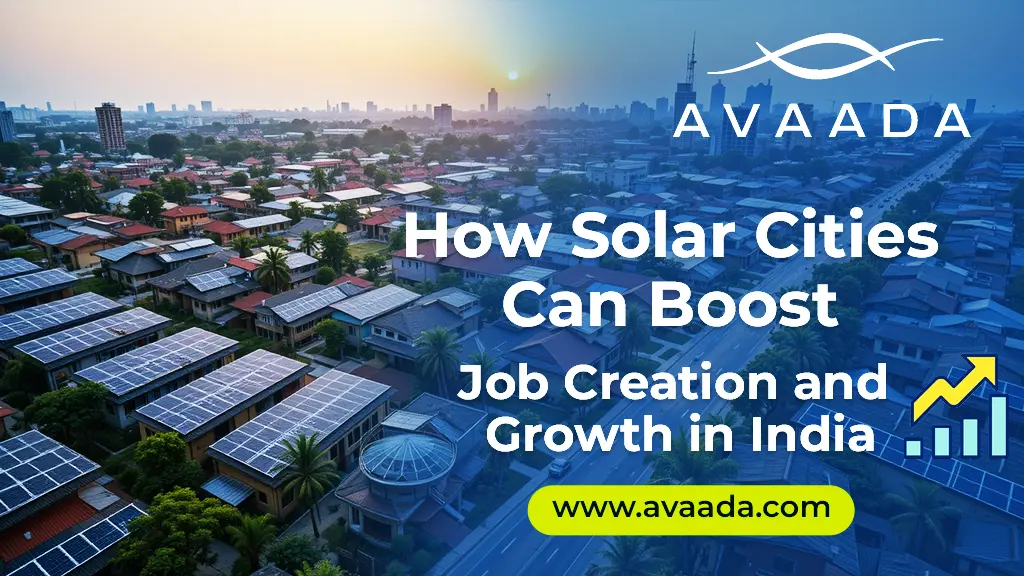India’s clean energy drive has opened a new and promising chapter with Uttar Pradesh’s ambitious project to convert all 17 of its municipal corporations into solar cities. With the nation moving towards its net-zero goals, this state-driven revolution can be a template for city sustainability, clean energy uptake, and economic growth. With encouragement from industry leaders such as Avaada, one of the top solar companies in India, the Solar City model is going to spur growth and employment across various directions.
The Solar City Vision: Clean Power for Urban India
Chief Minister Yogi Adityanath recently announced that all Uttar Pradesh’s municipal corporations will be turned into solar cities. As part of this, public infrastructure like government offices, streetlights, bus stops, schools, and water treatment plants will be equipped with solar power systems. The aim? To reduce carbon emissions substantially and encourage green city living.
Cities such as Ayodhya and Varanasi are already at the forefront. Ayodhya, for example, is now being recognized as the state’s first official “solar city,” demonstrating how to incorporate clean energy into a city’s power grid. This blueprint has the potential to significantly lower municipal electric bills as well as enhance energy resilience.
Avaada's Role: Powering the Future of Solar Cities
A key driver in this revolution is the entry of firms such as Avaada. With their sophisticated solar technology and extensive project experience, Avaada is one of the top solar firms in India.
Avaada commissioned a state-of-the-art 1.5 GW solar module production facility at Noida, Uttar Pradesh. The plant specialises in high-efficiency TOPCon N-type bifacial glass-to-glass PV modules, incorporating advanced multi-bus bar configurations (16 to 24 bus bars) to maximise efficiency. With M10, G12R and G12 cell production capabilities, the plant boasts an annual capacity of 1.2 GW for M10 modules and 1.5 GW for G12 & G12R modules, producing 5,800 modules daily. Each panel undergoes stringent quality checks to ensure reliability and peak performance.
Further strengthening India’s self-reliance in solar manufacturing, Avaada’s upcoming 5 GW integrated solar module manufacturing facility in Greater Noida will set new benchmarks for India’s solar industry. Spread over 50+ acres in Ecotech-16, the plant will produce cutting-edge 6GW TOPCon N-Type solar cells with industrial-scale high efficiency. With a significant investment, the project is expected to create over 3,000 jobs and obtain international certifications such as BIS, IEC, and UL, reinforcing Avaada Group’s commitment to global quality standards.
This massive investment is not merely an infusion of infrastructure; rather, it’s a dynamic driver of local job creation and technological skill-building in the renewable energy industry.
For insights into the latest developments and future outlook of the solar panel manufacturing hub, check out the blog on ‘What Types of Jobs Will the Solar Manufacturing Hub in Nagpur Create?’.
Jobs, Investment, and Innovation
Perhaps the strongest feature of the solar city program is that it can generate thousands of direct and indirect employment opportunities. Throughout the entire supply chain, from manufacturing solar panels and installing them to servicing them and connecting them to the grid, there will be a broad range of employment opportunities.
Major job creation sectors are:
- Manufacturing & assembly: Units such as Avaada’s plant in Noida need engineers, machine operators, quality controllers, and logistics personnel.
- Installation & EPC services: Solar rollout within municipal buildings and public areas creates opportunities for electricians, technicians, and construction employees.
- Operations & maintenance: Ongoing maintenance of solar installations guarantees a constant requirement for skilled maintenance staff.
- Training & innovation: Solar cities would require R&D assistance and training programs for manpower, stimulating local educational institutions to provide specialised solar training courses.
Sustainable Growth
Local government corporations have the ability to make a direct contribution to society. Through embracing solar power, the corporations are able to:
- Minimise the cost of running the operations in terms of lower electricity bills.
- Divert the savings to other public utilities like sanitation, education, and health.
- Foster environmental consciousness among people.
- Cleaner air will be created by decreasing our reliance on fossil fuels.
Also, the mass implementation of solar power will promote more environmentally friendly urban planning strategies like green architecture, EV charging stations, and smart grids.
The Road Ahead
As India ramps up its renewable energy capacity, efforts such as Uttar Pradesh’s solar city initiative are a shining example of what can be achieved when state policy, urban administration, and private enterprise come together. The participation of leading solar players such as Avaada also adds strength to the solar city model as a centre of economic prosperity and clean energy leadership.
If adopted effectively, the solar city model can be replicated nationwide, with all urban hubs contributing to India’s clean energy agenda as well as creating employment for local communities and improving infrastructure.
Conclusion
By adopting solar cities, India’s municipal corporations are not merely investing in cleaner energy, they are creating a greener economy, creating jobs, and improving urban life. Through the support of visionaries such as Avaada, the sun is indeed breaking on India’s sustainable dawn.









